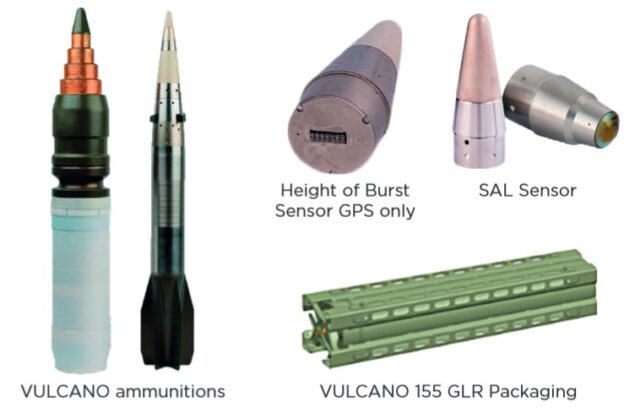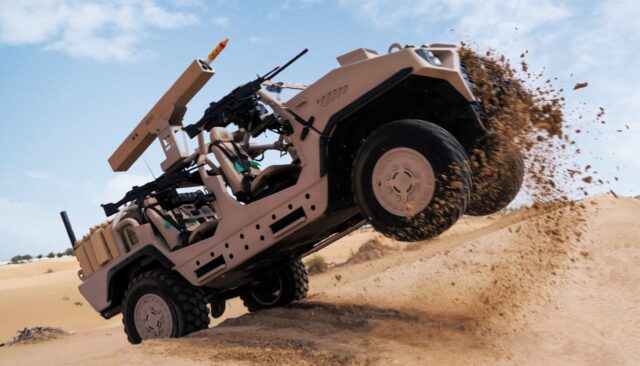A good opportunity has come to look at what weapons were handed over by Germany to Ukraine during the war that has already been going on for six months. There is surprising information about the supply of Vulcano precision ammunition caliber 155 millimeters, developed by Leonardo and Diehl Defense concerns. It allows you to precisely hit targets at distances of up to 70 kilometers. What’s more, the combination of semi-active guidance on reflected laser light and satellite navigation allows you to strike moving targets as well.
Let us skip the detailed technical description of the ammunition here, only mentioning that, according to the manufacturer, it is perfect for fighting one of the favorite targets of Ukrainian artillerymen – enemy command posts. Something else is important: Ukraine will be the first user of the Vulcano 155, and thus the first to gain experience from using it in combat conditions. So far, the interest in the ammunition has been shown mainly by the Germans, which chose it as an element of modernization of their own PzH 2000 self-propelled howitzers.
-ADVERTISEMENT-

The Bundeswehr is currently conducting qualification tests, the introduction to service is planned for 2025. According to the information provided by Soldat & Technik, Germany will only buy the ammunition in the Vulcano GLR (Guided Long Range) SAL (Semi Active Laser) laser guided variant. The placement tests are scheduled for November this year and will be conducted in South Africa. The training grounds there are a popular place for long-range artillery trials.
In the case of Ukraine, S&T indicates that the systems capable of using Vulcano are primarily PzH 2000 self-propelled howitzers and FH70 towed howitzers supplied by Germany and the Netherlands. The ammunition was tested on these types of guns. However, the use of other systems from the very diverse Ukrainian artillery park should not be ruled out.

Vulcano ammunition, steering system sensors and cartridge holder.
(Leonardo)
The scale of supplies remains the main bottleneck. The German defense ministry has announced that it will hand over only 255 units. However, the delivery date was not specified. In view of the intensity of artillery fire at the front, such a figure seems like a drop in the ocean. On the other hand, it must be remembered that the production of Vulcano 155 is limited and, like the entirety of military production in the West, it must be launched, and for this it takes time, and wisely used precision ammunition, even in small quantities, will allow you to destroy the most valuable targets in the blast zone.
Incidentally, it is also worth mentioning the deliveries of M982 Excalibur precision ammunition announced by the USA. Here, however, neither the planned number of missiles nor the delivery date are given. Rumors about the delivery of the M982 to Ukraine have been circulating for some time, even materials appearing to prove their combat use. Excaliburs are intended for towed M777A2 howitzers, but can also be used by the Dutch PzH 2000.
#Ukraine: Possibly the first video of the American M982 Excalibur in action: as claimed, guided shells fired from a M777A2 howitzer were used in #Kherson Oblast.
We can see two entrenched Russian Kamaz-63501AT artillery trucks and a dugout being destroyed with precise fire. pic.twitter.com/qlZjglonR9
– 🇺🇦 Ukraine Weapons Tracker (@UAWeapons) August 18, 2022
As we are talking about PzH 2000 – in recent weeks, a storm has swept around these howitzers by the media, including German ones. Allegedly, they quickly became unable to fight, or were even completely unsuitable for such intensive use as on the front with Russia. There is much exaggeration in these reports. The losses turn out to be lower than originally assumed, and most of the problems are caused not by faulty design, but by a lack of spare parts. Let us remind you that the logistics of the Bundeswehr is disastrously organized and has been neglected for years.
… only one AHS was irretrievably lost. There were no irreversible losses in relation to the second batch of Krabs.
The problem is the losses due to the lack of spare parts. However, the case of PzH 2000 shows that their level is still lower than expected.
– Piotr Zbies (@Zbiesu) August 19, 2022
What do they and what don’t they deliver?
German supplies to Ukraine, or rather reluctance to them, began to be the subject of controversy even before the outbreak of the war. It is no different after February 24, it can even be said that for every step forward, Berlin takes a half step back. After all, deliveries are ongoing, and much of the confusion is related to a disastrous information policy. The German Ministry of Defense is trying to do something in this field and has started publishing the most important data on its website, also in English and French. According to the ministry’s data, from January 1 to August 8, 2022, Germany transferred military equipment to Ukraine with a total value of over 686 million euros.
What was delivered? We have already described a large part of the donated equipment and the accompanying adventures many times. The heavyweight is the most carrying weight, and here the Gepard self-propelled anti-aircraft sets (fifteen so far, ultimately thirty) and the PzH 2000 self-propelled howitzers come to the fore. The Germans aim at light weapons and auxiliary equipment. In addition to the Stinger and Striela manual anti-aircraft systems and the Panzerfaust 3 and RGW 90 Matador anti-aircraft systems, thirty-six different anti-drone systems, spare parts for the MiG-29, several thousand anti-tank mines and nearly 22 million ammunition must be replaced. In addition, equipment for field hospitals, tents, power generators and over 400,000 food rations.
Future deliveries also look interesting, and while not attracting media attention, they will help strengthen the Ukrainian armed forces. This group includes another sixty-four anti-drone systems, twelve Bergepanzer 2 technical support vehicles and sixteen Biber accompanying bridges. In addition, unmanned aerial and surface systems, ammunition of various calibers and first aid kits. As for the heavier technique, it is worth mentioning twenty 70-millimeter rocket launchers mounted on pickups along with 2,000 rockets and laser target markers. Chancellor Scholz also announced the imminent handover of the IRIS-T SLM anti-aircraft system.

The 70 mm caliber missile launchers are probably some variant of the Arnold Defense LAND-LGR4 Fletcher platform mounted on unspecified off-road vehicles. A single LGR4 container is 189.2 cm long and weighs 27.2 kg without shells.
(Arnold Defense)
Germany donated more heavy equipment than France, only it didn’t sell it to the media at all. Another problem is the expectations of Ukraine and its allies. In a guest article for Spiegel, three politicians from the ruling coalition: Sara Nanni (Greens), Kristian Klinck (SPD) and Alexander Müller (FDP), openly stated that more is expected of Germany as Europe’s largest economy.
The authors strongly support increasing the supply of weapons to Ukraine, including heavy equipment. They also call for a complete reorganization of relations between the government, trade unions, the arms industry and the military. The mechanisms developed over the past three peaceful decades are completely inconsistent with the present conditions. It is supposed to be more transparent, credible and predictable in order not only to meet the needs of the Bundeswehr and support the German economy, but also to improve relations with allies.
Olaf Scholz announced the delivery of the IRIS-T air defense system and the COBRA counterbattery radar to Ukraine
According to the German chancellor, they “will soon be” in #Ukraine.
He added that #Germany would continue to supply Ukraine “with what it needs for defense.” pic.twitter.com/sdw0YzKgrX
– NEXTA (@nexta_tv) August 21, 2022
The latter are in a terrible condition thanks to Chancellor Scholz and Defense Minister Christine Lambrecht. However, a glimmer of hope appears. It is about Ringtausch (“district exchange”), which assumed that NATO countries from the former Eastern Bloc would hand over Soviet-style tanks and infantry fighting vehicles to Ukraine, and in return they would receive German vehicles. So far, most of the negotiations on this matter with Poland, Slovenia and Greece have been on the brink of failure. Now Slovakia has a chance to break the losing streak.
On August 23, German Deputy Defense Minister Benedikt Zimmer arrived in Bratislava. The very first comments suggested that he was more competent than Lambrecht and had a chance to save Ringtausch. So it happened. As part of the agreement signed on the same day, Slovakia is to hand over thirty BVP-1 infantry fighting vehicles to Ukraine, and in return it will receive fifteen Leopard 2A4s later this year. This is a bit of an enigmatic matter, because according to earlier information, including the German edition of Business Insider, Bratislava was to hand over all 30 owned T-72M tanks. The Slovak government was to refuse to accept such a transaction and refuse to accept the Leopard 2A4s, demanding German tanks in one of the newer versions for the T-72.
My deputy @MajerMarian just signed #Ringtausch deal w / German Deputy Minister of Defense Benedikt Zimmer at @mosr_official. #Slovakia will send its 30 IFVs to #Ukraine 🇺🇦 & get 15 Leopard2A4 MBT from #Germany. 🇸🇰🤝🇩🇪 #WeAreNATO @BMVg_Bundeswehr @oleksiireznikov @Slovakia_NATO pic.twitter.com/xXG8S7GXJg
– Jaro Nad (@JaroNad) August 23, 2022
See also: Are we dealing with an arms race over the Aegean Sea?
US Army / Spc. Nathanael Mercado

